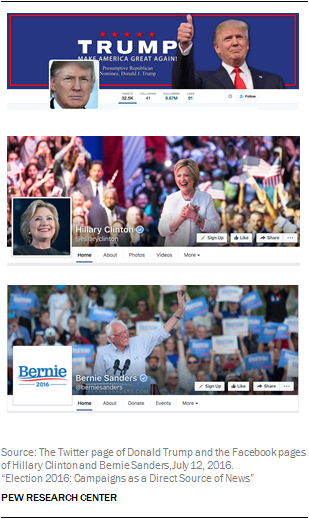
A new Pew Research Center analysis of three weeks of the candidates’ Facebook and Twitter accounts finds both similarities and differences in the ways Hillary Clinton, Donald Trump and Bernie Sanders use these still relatively new campaign tools. The study of 714 tweets and 389 Facebook posts made by the candidates between May 11 and May 31, 2016, finds that the three candidates post at similar rates but differ in the focus of these posts and in the attention they receive from the public. On Facebook, Clinton and Sanders mostly use links to highlight official campaign communications while Trump links frequently to the news media. On Twitter, Trump stands out for retweeting ordinary people more often than Clinton or Sanders (though retweets are rare). Videos, meanwhile, appeared in about a quarter of Clinton’s social media posts, compared with about one-in-ten of Trump’s; Sanders used video far more on Facebook than on Twitter. Finally, on both platforms, when the candidates mention their opponents, Clinton and Trump focus on each other while Sanders goes largely unmentioned.
Overall, people who follow these candidates on social media see the daily cycle of the campaign through a narrow window. Candidates naturally select messages beneficial to their campaigns to share with followers. While Clinton mostly passes on messages crafted by the campaign itself, Trump reaches out to news media and the public. Sanders employs a mix of campaign communications and news media in his posts.
These are some of the findings from an analysis of the candidates’ social media activity during a period in the campaign when Trump had become the presumptive Republican nominee and Clinton was still trying to secure the Democratic nomination as Sanders fought on. Content was collected from the Twitter and Facebook API and hand-coded by a team of researchers. (For more information, see our methodology – LINK]).
Clinton and Sanders post as frequently as Trump – but his tweets and Facebook posts get far more attention
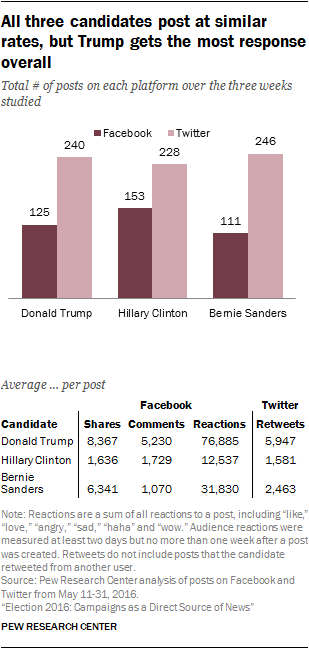
Over the three weeks studied, Donald Trump, Hillary Clinton and Bernie Sanders posted on Facebook and Twitter at roughly similar rates, averaging five to seven posts per day on their Facebook pages and 11-12 posts per day on their Twitter accounts.
While the candidates’ level of posting was about the same, public response was far from equal.6 In every measurable category of user attention – Facebook shares, comments, and reactions, as well as Twitter retweets – the public responded to Donald Trump’s social media updates more frequently on average than to either of the other candidates’ posts. Trump’s posts on Twitter, for example, were retweeted almost 6,000 times on average compared with just over 1,500 for Clinton and almost 2,500 for Sanders.7 This may be due in part to Trump’s higher number of followers. Near the time of publication, he had almost 10 million followers on Twitter compared with Clinton’s 7 million and Sanders’ 3 million, while on Facebook, 9 million followed Trump’s official page, about double the number who followed either Clinton’s or Sanders’ pages.
Both Trump and Sanders had a few posts that received outsized responses. Sanders’ declaration on Twitter that he would debate Trump, for example, had received roughly 28,000 retweets at the time of the study, while a Facebook post from Sanders celebrating Native Americans received over 52,000 shares. And Trump’s tweet attacking Clinton on gun control had received about 16,000 retweets, while his Facebook post supporting police was shared over 72,000 times. Comparatively, Clinton had no breakout posts or tweets in this period, instead collecting a fairly steady number of interactions on her posts and tweets. Her most retweeted tweet, about drought conditions in California, had received about 5,600 retweets at the time of analysis, while her most highly shared Facebook post was a video attacking Donald Trump that was shared 15,000 times. Even accounting for the posts that drew overwhelming attention, Trump still received the most public response. Looking at the median – or middle point – rather than the average number of interactions per posts puts less weight on the extremes, and under this metric, Trump maintains his top position.
Game on. I look forward to debating Donald Trump in California before the June 7 primary.
— Bernie Sanders (@BernieSanders) May 26, 2016
With one major exception, the level of social media activity by the candidates is higher than during the 2012 presidential campaign. The Center’s study of a similar timeframe that year found that candidates Barack Obama and Mitt Romney updated their Facebook statuses twice a day, on average – less than half as often as the 2016 candidates. On Twitter, Romney averaged just one tweet a day, again far lower than the 2016 candidates. However, in 2012 Obama far outpaced both Romney and the 2016 candidates studied, averaging 29 tweets per day. (These tweets were spread across two accounts, though both were officially tied to the campaign.)
The public response in 2016 is a little harder to compare due to the substantial differences by candidate as well as a slight change in the study’s methodology across time.8 However, it is worth noting the overall numbers as a general reference point. In 2012, Obama’s Facebook posts received over 40,000 likes on average, while Romney’s received about 19,000; on Twitter, both received fewer than 600 retweets per post.
In terms of total followers, Obama’s 2012 campaign had a much larger number of followers than the 2016 candidates as well as his own rival at the time – though much of this almost certainly stems from the fact that Obama was a sitting president running for a second term. At the time of the 2012 analysis, Obama had more than 27 million Facebook followers and about 18 million Twitter followers across his two accounts. This is far higher than Trump, the 2016 candidate with the highest number of followers (10 million on Twitter and 9 million on Facebook). Romney had about 3 million Facebook and about 800,000 Twitter followers in 2012, far fewer than any 2016 candidate.
Clinton and Sanders link to their campaign websites, while Trump links to news media
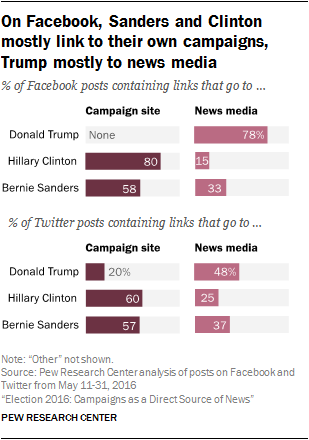
One common practice in social media is to add links to external web pages, news articles or other online material when creating a post. In the context of a political campaign, a link within a social media post can help a reader find more information, become more involved with the campaign or lend credibility to the post’s content. During the time period analyzed, the use of links by Trump, Clinton and Sanders varied, both from one candidate to the next and across the two social networks studied.
Within their Facebook posts, the candidates included external links at similar rates: 30% of Clinton’s posts on Facebook included links, as did 32% of Sanders’ posts and 30% of Trump’s posts.9 What they linked to, however, varied a great deal. Like Obama and Romney in 2012, Clinton’s and Sanders’ Facebook feeds most often linked to their own official campaign websites or social media accounts. Fully 80% of Clinton’s Facebook posts with links went to campaign pages, as did 58% of Sanders’ Facebook posts. These include links to campaign events, videos (both recorded and streaming) and donation pages.
Links to news media outlets were considerably less common for these two Democratic candidates. Only 15% of the posts with links in Clinton’s Facebook feed directed readers to news articles. In comparison, news media links from organizations such as Politico, Univision and medium.com comprised a third (33%) of posts with links in the Sanders feed.
Trump’s Facebook posts, on the other hand, more frequently pointed readers to news media. Fully 78% of his posts with links directed followers to articles from large national or international media organizations such as Fox News and the Daily Mail, as well as more niche sites like the conservative magazine The American Spectator. Trump never linked to his campaign site in a Facebook post. This seems to be in line with Trump’s general strategy of focusing on media appearances and rallies during this period, rather than volunteers or donations.
On Twitter (where Clinton and Sanders include links about a third of the time and Trump just a tenth), a similar pattern emerges.
Sanders most often linked to his own campaign websites (57% of all links) followed by news media (37%), roughly the same rate as he did on Facebook. Clinton similarly linked to her own campaign 60% of the time on Facebook and the news media a quarter of the time. And Trump again linked most frequently to news sites (48% of posts with links), although, in contrast to Facebook, he did link to his campaign site on Twitter in 20% of all links he posted.
On Twitter, Trump primarily retweets the public, while Sanders retweets the news media and Clinton retweets her campaign
Another way of engaging with others on social media is to directly repost content posted by someone else – whether a media organization, another political figure or a member of the public.
On Facebook, Sanders was the only one of the three candidates to share someone else’s posts during these three weeks studied – and he only did so twice.
On Twitter, however, all three did at least some promotion – or retweeting – of outside content.
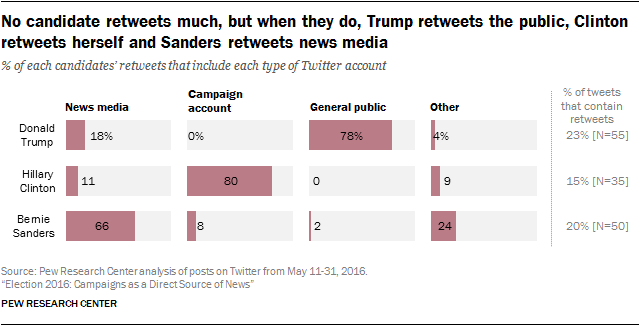
About a quarter (23%) of Trump’s tweets were retweets, as were one-in-five of Sanders’ and 15% of Clinton’s. The candidates’ retweets, however, reflected different strategies. Trump was most likely to retweet the public, Clinton her own campaign accounts and Sanders the news media. Of Trump’s 55 retweets, about eight-in-ten (78%) were of people who were not famous and had no discernable ties to news media, government or other organizations – in other words, the general public. Most were of supporters offering congratulations or compliments to Trump, to which he often responded at the end of the post (see example).10 Some, though, were posts that made critical statements about others; Trump has taken some criticism for these types of retweets. In a May debate, for example, Fox News host Megyn Kelly questioned Trump about his retweets of derogatory statements about Kelly made by private citizens.
“@markgruber1960: @megynkelly@realDonaldTrump That’s why he is so successful. He is driven to succeed” True!
— Donald J. Trump (@realDonaldTrump) May 18, 2016
Clinton and Sanders, on the other hand, almost never retweeted the public during the time studied. Just one post from Sanders was a retweet of someone outside the public sphere, while the public was not the source of any of Clinton’s retweets. Instead, 80% of Hillary Clinton’s 35 retweets were of her own staff or of her campaign’s other accounts. About four-in-ten (43%) of these campaign retweets were retweets of @TheBriefing2016, a fact checking account of the Clinton campaign with the stated purpose of “setting the facts straight.”
While American families suffered, Donald Trump tried to cash in. https://t.co/BvkHu63H1h
— The Briefing (@TheBriefing2016) May 24, 2016
Sanders, on the other hand, is the most likely candidate to retweet news media (66% of his 50 retweets). Another 24% of his retweets were of other types of accounts, including 12% that were celebrity accounts. In contrast, Clinton never retweeted a celebrity account.
Trump’s unique engagement with the public on Twitter stands apart not just from the other 2016 candidates but also from past presidential campaigns. In 2012, the candidates’ social media outreach offered little engagement with the public. Just 3% of Obama’s tweets during the period studied were retweets of the public – and most of these were posted during a live Twitter Q&A. Romney rarely used the retweet functionality and never retweeted the public.
Trump and Clinton mention each other frequently
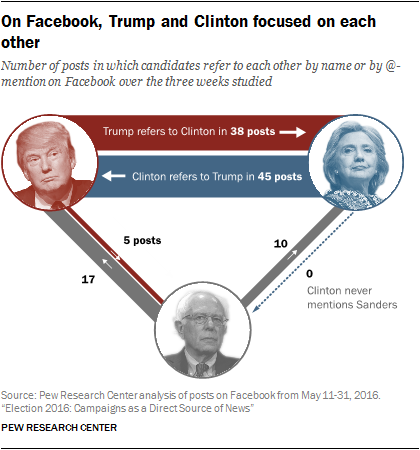
Facebook and Twitter users can refer to others on the site in a few different ways. One is by directly linking to their accounts in a post. On Twitter, these are called @-mentions. There is no formal name for this functionality on Facebook, but the process and effect are largely the same. Short of this formal mention, a user could simply refer to that person or organization by name in plain text. Each carries a somewhat different message. The links, or @-mentions, alert the individual or organization of the reference and can direct readers to the accounts mentioned. By including this link instead of just their name, the original user can include other users in the conversation, acknowledge their contributions or direct followers to their accounts. In contrast, when a user refers to another individual without the link to their account, it suggests that the discussion is intended for only the original user’s followers.
The 2016 candidates used a combination of these approaches in mentioning their opponents, while only Trump and Clinton regularly used the formal mention functions to refer to other users on Facebook and Twitter.
Candidates referring to each other
In the waning days of the primaries studied here, with Trump the presumptive nominee and Clinton ahead in delegate counts, most of the candidate cross-talk was between Trump and Clinton. On Facebook, Clinton and Trump mentioned each other at similar rates – in about three-in-ten of their posts. Both most often did so through the less formal text mention. However, 13 of Clinton’s 45 posts mentioning Trump did so using the official Facebook mention function thereby alerting Trump and linking readers directly to his page. None of Trump’s posts used the formal mention function to link to Clinton’s page, and in nearly all (32 of the 38 posts), he referred to her as “Crooked Hillary.”
When it came to Sanders, more interactions occurred on Facebook between Sanders and Trump than between the two Democratic rivals. Clinton never mentioned Sanders using either format while Trump mentioned him only five times, usually to boost Sanders’ campaign at the expense of Clinton’s. Sanders mentioned Trump more often (17 times) than Clinton (10 times) but named neither Clinton nor Trump at the rates they mentioned each other.
On Twitter, the focus was again on Trump and Clinton referring to each other, but here, Clinton referred to Trump at twice the rate that Trump referred to her. Fully 40% of Clinton’s tweets referred to Trump (whether by name or using an @-mention), compared with 19% of Trump’s tweets that mentioned Clinton – the majority of which again used the “Crooked Hillary” nickname. Aside from this, the pattern remained mostly the same. Clinton never referred to Sanders, while Sanders mentioned Clinton about half as often as he mentioned Trump (10 times to 19 times). And Trump referred to Sanders in 5% of his tweets – again, most of which were supportive of Sanders’ efforts to beat Clinton.
In these mentions, the candidates only rarely used the @-mention function. Trump used Clinton’s and Sander’s Twitter handles in an @-mention only once each; Sanders also used an @-mention one time for each candidate. Clinton did so more frequently, but still very rarely: 16 of Clinton’s 92 tweets referring to Trump did so using an @-mention.
Formal mentions of other users
While the candidates did not often refer to each other using the formal mention functionality built into Facebook and Twitter, both Trump and Clinton used this method to highlight other users.11
Trump formally mentioned another user 29 times in his Facebook posts. As with his links, the news media got the most attention, making up 38% of his user mentions. His second most-mentioned category was family members (28% of his mentions), naming his daughter Ivanka four times, his son Donald Jr. three times and his son Eric once. Celebrities, from musician Billy Joel to golfer Jack Nicklaus, made up 17% of his mentions, while politicians made up just 14%.
Clinton, on the other hand, mentioned other users 33 times in her Facebook posts, with politicians accounting for about half (52%) and news media accounting for just 12%. She mentioned celebrities roughly as often as Trump did (18% of her mentions), but she focused on considerably different people, mentioning TV host Ellen DeGeneres and musicians such as John Legend, Ricky Martin and Andra Day.
On Twitter, the pattern was largely the same, though neither celebrities nor family members were present in the same numbers. Trump @-mentioned other users 112 times. In these mentions, he focused largely on the news media, naming media outlets or journalists in about three-quarters (72%) of his @-mentions.12 Most informed followers of a TV news appearance, highlighted news stories about himself or his issues, or attacked particular outlets. The New York Times was the most frequent target of the latter type of mention, especially in the wake of an investigation it published into Trump’s relationship with women.
Thank you @DailyMail– for setting the failing @NYTimes story straight. This is what the NYT’s should have written! https://t.co/Feb6dhctQo
— Donald J. Trump (@realDonaldTrump) May 24, 2016
Clinton, however, named the news media in only 16% of her 50 formal mentions. She was most likely to mention other politicians (46%), including Trump, but also other prominent politicians such as President Barack Obama or former House member Gabby Giffords.
On both Facebook and Twitter, Sanders used the mention functionality less frequently. He formally mentioned another user in less than 10% of both his Facebook posts and his tweets.
Only Clinton and Sanders post in Spanish on Facebook and Twitter – but neither does so frequently
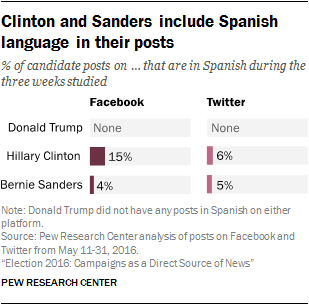
The vast majority of posts from all candidates were written in English. However, Donald Trump’s campaign posted only in English, while both Hillary Clinton and Bernie Sanders occasionally posted in Spanish during the time period studied. Spanish language posts constituted 15% of Clinton’s Facebook posts and 6% of her tweets, while 4% of Sanders’ Facebook posts and 5% of his tweets were in Spanish. This is reflective of the campaigns’ outreach to Spanish-speaking communities, particularly in California, which voted soon after the end of the collection period. Spanish language posts ranged from tweets sharing Spanish-language news media to messages targeted to Spanish-speaking communities – sometimes direct translations of English-language posts.
(It’s only Wednesday.) pic.twitter.com/IPkbU8xdaw
— Hillary Clinton (@HillaryClinton) May 18, 2016
… y solo es miércoles. pic.twitter.com/ZWwByVX2vm
— Hillary Clinton (@HillaryClinton) May 19, 2016
Clinton includes videos in about a quarter of posts on Facebook and Twitter, more than any other candidate
Since 2012, both Facebook and Twitter have enhanced their video capabilities, making it easier to include multimedia and adding features such as autoplay, which plays embedded videos as users scroll through their feeds without user input.
Amid these developments, Clinton stood out for using videos most frequently. About a quarter of both her tweets (27%) and her Facebook posts (23%) during the time period studied contained embedded videos. Sanders included videos in about one-in-five of his Facebook posts (21%) but only 9% of his tweets. Trump was the least likely to include videos on either platform, doing so just four times on Twitter (2% of his tweets) and in 13% of his posts on Facebook.
Generally, the videos both Clinton and Sanders posted were campaign ads. Sanders, however, was almost equally likely to post footage (or, in one case, a live stream) from his rallies. On Facebook, Clinton also posted videos showing the candidate talking with voters about policy issues in small groups. Trump’s handful of videos were generally of news footage or interviews with himself or members of his campaign.
Compared to 2012, Clinton and Sanders posted videos on par with or more frequently than either Romney or Obama did on Facebook or Twitter.
Beyond video, one novel social media technique used by the campaigns, not found in our studies of previous elections, was the use of images with prominent text and/or numbers to convey factual or message-based information.
Trump, for example, occasionally posted screenshots of polls or other news-related information. Clinton also posted screenshots, which were mostly text-heavy infographics designed around a single factoid or slogan such as “Two thirds of Americans earning the minimum wage are women.” The static images used by Sanders, on the other hand, tended to be infographics that shared information about rallies or voting, or conveyed celebrity endorsements. These kinds of static image-based posts can quickly convey information or messages to followers, but since they often do not include links, can make it difficult for users to confirm or find additional information.
Thank you America! #Trump2016 pic.twitter.com/xfINxdRNiQ
— Donald J. Trump (@realDonaldTrump) May 22, 2016
There’s so much more that unites us than divides us. It’s time to come together to stop Donald Trump. pic.twitter.com/aPDfBHHCaU
— Hillary Clinton (@HillaryClinton) May 24, 2016
Kentucky — It’s your turn to vote for our political revolution. Grab your friends and family and go out and vote. pic.twitter.com/Kx94yvZohq
— Bernie Sanders (@BernieSanders) May 17, 2016